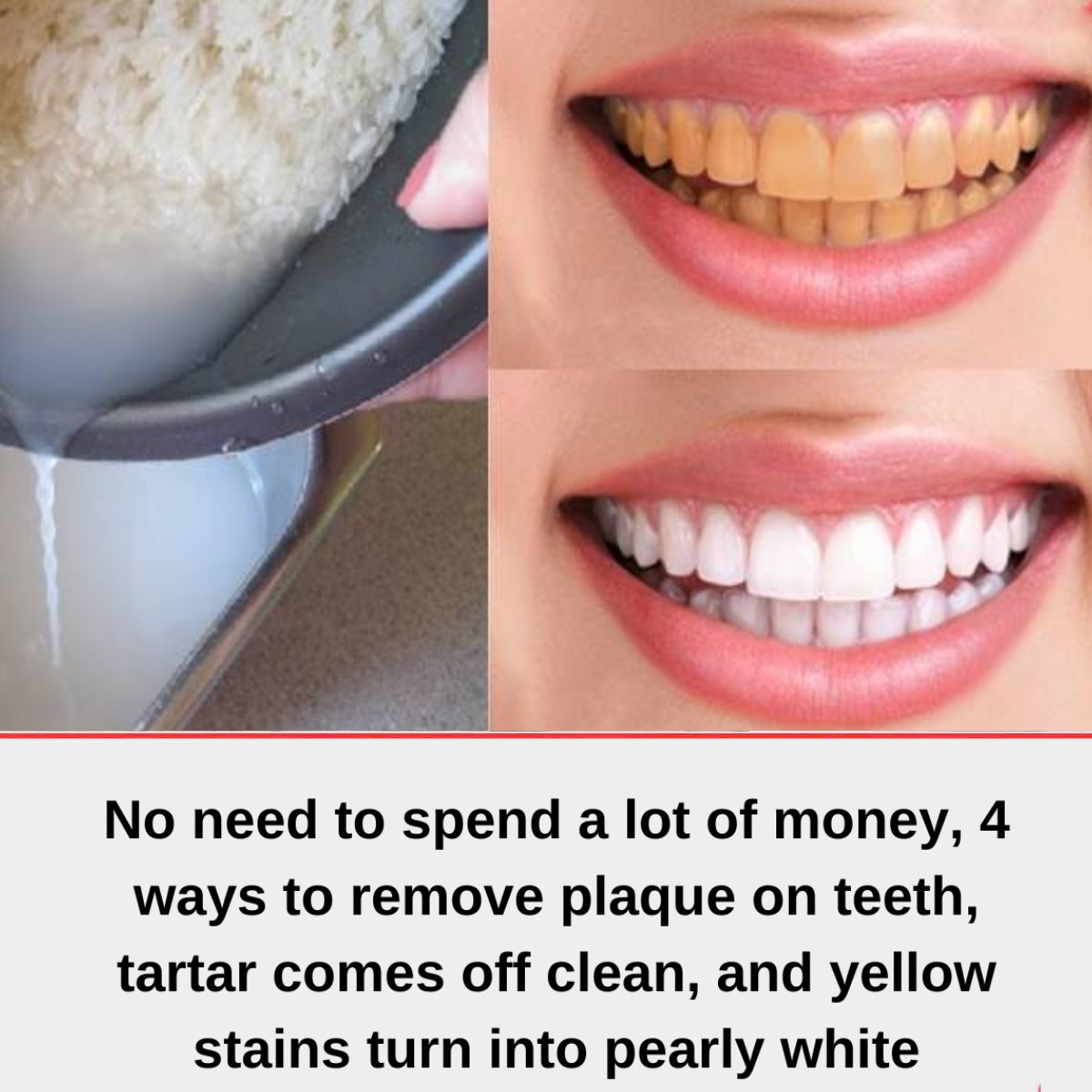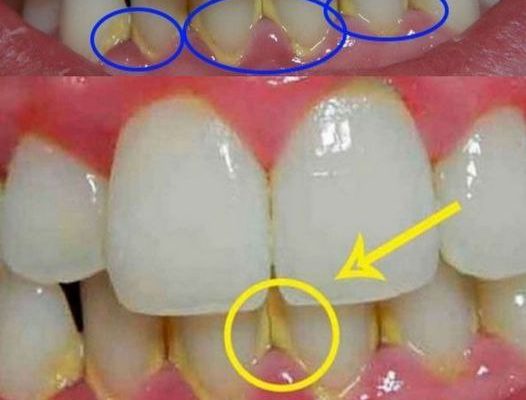Your smile is one of the first things people notice about you, and maintaining great oral health should be a priority. With so many teeth-whitening treatments available today, it’s easy to get caught up in quick-fix promises—like the idea that you can transform yellow teeth into a “milk-white, shiny” smile in just minutes. But before diving into any new whitening procedure, it’s crucial to approach with caution. Not all solutions are created equal, and some could end up doing more harm than good.
In this guide, we’ll explore the best natural ways to whiten teeth, remove plaque, and fight tartar—without compromising your enamel or health. And as always, consulting a dentist is the first step before beginning any teeth-whitening method.

Why Consult a Dentist First?
Before embarking on any teeth-whitening journey, it’s important to check in with your dentist. They can evaluate the overall health of your teeth and gums, identify the cause of any discoloration, and recommend the most effective and safest whitening methods for you. Whether your teeth are yellowing due to aging, food, or lifestyle habits, a dentist can guide you toward the right solution—tailored to your needs.
Teeth-Whitening Solutions You Can Find Over-the-Counter:
There’s a wide variety of OTC teeth-whitening products such as toothpastes, whitening strips, and gels. These are easy to access, but they often show gradual results rather than instant transformations. While they may slightly improve the color of your teeth over time, the effects are not immediate. Consistency is key—and it’s important not to overuse these products, as this could lead to enamel damage and tooth sensitivity. Always follow the manufacturer’s instructions carefully.
Natural Remedies for Teeth Whitening:
For those looking for a more natural approach, there are several home remedies you can try. While these remedies are often less potent than professional treatments, they can be effective for minor teeth whitening and plaque removal when used correctly:
Baking Soda:
Baking soda is a common ingredient in many natural whitening products, and for good reason. Its mild abrasiveness helps scrub away surface stains on your teeth. To use, dip a wet toothbrush into a small amount of baking soda and gently brush your teeth for two minutes. Just be sure not to overdo it, as excessive use can wear down enamel over time.
Activated Charcoal:
Activated charcoal is another popular option. It is believed to absorb toxins and may help remove surface stains. To use it, dip a damp toothbrush into the charcoal powder and brush gently. While some users report positive results, it’s important to remember that charcoal can be abrasive, so use it sparingly to avoid damage to your enamel.
Coconut Oil Pulling:
Oil pulling with coconut oil has been practiced for centuries in Ayurvedic medicine. Swishing a tablespoon of coconut oil in your mouth for 10-15 minutes can help remove bacteria, plaque, and potentially reduce stains. It’s a gentle, all-natural method that promotes overall oral health.
Rice Water Rinse:
An unexpected but effective natural remedy is rice water—the water left over after cooking rice. This is a practice used in some cultures for its mild whitening properties. Rice water contains minerals and compounds that can help strengthen teeth and potentially remove surface stains when swished in the mouth. Simply collect the water after rinsing or boiling rice, and swish it around in your mouth for a few minutes. It’s gentle on the enamel and can be done regularly as part of a natural teeth care routine.
In-Office Whitening Treatments:
While home remedies can help with minor discoloration, professional whitening treatments are often more effective and provide quicker results. Dentists can offer in-office teeth whitening using gels that contain hydrogen peroxide or carbamide peroxide, combined with special lights to accelerate the bleaching process. These treatments are generally safe when performed by a professional and can produce noticeable results in a single session.
For a more gradual approach, dentists may recommend take-home whitening kits that allow you to whiten your teeth at your own pace. These kits typically include custom-fitted trays and a milder whitening gel.
Lifestyle Modifications to Prevent Staining:
Preventing new stains is just as important as whitening existing ones. Certain foods and beverages—such as red wine, coffee, tea, and cigarettes—are notorious for staining teeth. While it’s not realistic to cut them out completely, limiting your intake or drinking water immediately after can help minimize staining.
Maintaining a solid oral hygiene routine is also crucial. Brushing your teeth at least twice a day, flossing daily, and using mouthwash regularly will help prevent plaque buildup and keep your teeth looking their best.
Be Aware of Overuse and Potential Risks:
It’s important to keep in mind that teeth-whitening products—whether natural or over-the-counter—can only achieve so much. Overusing certain remedies, particularly those that are abrasive (like baking soda or charcoal), can lead to enamel erosion and sensitive teeth. Always use whitening products in moderation and follow recommended guidelines to avoid causing long-term damage.
Takeaways:
Consult with a dentist before starting any teeth-whitening regimen to ensure you’re using the right products and methods for your unique needs.
Natural remedies like baking soda, coconut oil pulling, and rice water rinsing can help whiten teeth and remove plaque, but they must be used carefully and sparingly.
Professional whitening treatments at your dentist’s office are often more effective and faster than home methods.
Make lifestyle changes—like limiting stain-causing foods and maintaining regular brushing habits—to keep your teeth bright and healthy.
Remember, patience is key when it comes to teeth whitening, and taking care of your enamel should always come first. With the right approach and a little consistency, you can enjoy a healthier, brighter smile that lasts for years!




официальный сайт 1win http://1win6001.ru .
1 vin официальный сайт 1 vin официальный сайт .
1 вин официальный сайт вход https://1win6001.ru .
1вин онлайн [url=https://familyclub.borda.ru/?1-6-0-00002163-000-0-0-1743051813]https://familyclub.borda.ru/?1-6-0-00002163-000-0-0-1743051813[/url] .
aviator mostbet http://www.mostbet6006.ru .
мостбет скачать бесплатно https://mostbet6006.ru .
1 win kg https://www.familyclub.borda.ru/?1-6-0-00002163-000-0-0-1743051813 .
мостбет скачать казино http://www.mostbet6006.ru .
официальный сайт 1win https://1win6049.ru/ .
1win pro https://alfatraders.borda.ru/?1-0-0-00004932-000-0-0-1743258210/ .
1win футбол http://1win6049.ru .
1вин кыргызстан https://alfatraders.borda.ru/?1-0-0-00004932-000-0-0-1743258210 .
Заказать диплом о высшем образовании!
Мы можем предложить документы институтов, которые расположены на территории всей Российской Федерации. Документы выпускаются на бумаге самого высокого качества: 064.ru/images/pages/?kupit_diplom_tehnikuma_po_dostupnoy_cene.html
1вин вход 1вин вход .
1win официальный сайт регистрация balashiha.myqip.ru/?1-12-0-00000437-000-0-0-1743258848 .
1win кыргызстан http://1win6049.ru .
1вин вход http://www.balashiha.myqip.ru/?1-12-0-00000437-000-0-0-1743258848 .
1 win официальный http://1win6050.ru .
Мы готовы предложить дипломы любой профессии по невысоким ценам. Купить диплом колледжа — kyc-diplom.com/diplom-kolledzha.html
1win официальный сайт https://obovsem.myqip.ru/?1-9-0-00000059-000-0-0-1743051936 .
1win kg скачать http://1win6050.ru .
1 win регистрация 1win6050.ru .
1win казино https://www.obovsem.myqip.ru/?1-9-0-00000059-000-0-0-1743051936 .
скачать 1win официальный сайт https://1win6050.ru/ .
mostbet kg отзывы https://www.svstrazh.forum24.ru/?1-18-0-00000136-000-0-0-1743260517 .
1 win.com obovsem.myqip.ru/?1-9-0-00000059-000-0-0-1743051936 .
mostbet официальный сайт mostbet официальный сайт .
1 вин официальный сайт http://www.obovsem.myqip.ru/?1-9-0-00000059-000-0-0-1743051936 .
мостбет промокод https://svstrazh.forum24.ru/?1-18-0-00000136-000-0-0-1743260517 .
1вин войти 1вин войти .
1vin казино [url=https://1win6051.ru]https://1win6051.ru[/url] .
ванвин http://1win6052.ru/ .
1win kg скачать https://www.1win6052.ru .
1win. com https://1win6051.ru/ .
вин 1 1win6052.ru .
что делать с бонусным балансом на 1win http://www.1win6051.ru .
Где заказать диплом специалиста?
Приобрести диплом университета по доступной цене возможно, обратившись к проверенной специализированной фирме.: ry-diplom.com
1win официальный сайт скачать 1win официальный сайт скачать .
мосбет http://mostbet6029.ru .
1win win http://www.1win6053.ru .
мостбет авиатор https://mostbet6029.ru .
aviator mostbet http://mostbet6029.ru/ .
Задался вопросом: можно ли на самом деле купить диплом государственного образца в Москве? Был приятно удивлен — это реально и легально!
Сначала искал информацию в интернете на тему: купить диплом в нижневартовске, купить диплом в альметьевске, купить диплом в магнитогорске, купить диплом в ростове-на-дону, купить диплом в ханты-мансийске и получил базовые знания. В итоге остановился на материале: proffdiplomik.com/diplom-dlya-inostr-grazhdan
Приобрести диплом любого университета. Заказ документа о высшем образовании через надежную фирму дарит ряд плюсов. Это решение позволяет сберечь время и значительные финансовые средства. somalibidders.com/employer/eonline-diploma
pariuri sportive moldova https://www.1win5011.ru .
Мы готовы предложить дипломы психологов, юристов, экономистов и других профессий по невысоким ценам.
Вы покупаете диплом через надежную и проверенную фирму. Приобрести диплом академии– http://silton.ru/forum/user/7964/ – silton.ru/forum/user/7964
Где приобрести диплом по актуальной специальности?
Мы изготавливаем дипломы психологов, юристов, экономистов и любых других профессий по доступным ценам. Важно, чтобы документы были доступны для большинства наших граждан. Заказать диплом любого ВУЗа diplomk-vo-vladivostoke.ru/kupit-diplom-s-reestrom-37/
1win md https://1win5010.ru/ .
1win md https://1win5011.ru/ .
Где купить диплом специалиста?
Мы предлагаем быстро и выгодно купить диплом, который выполняется на бланке ГОЗНАКа и заверен мокрыми печатями, штампами, подписями. Документ пройдет лубую проверку, даже с применением профессиональных приборов. Решите свои задачи быстро и просто с нашей компанией.
Заказать диплом любого университета vacshidiplom.com/kupit-diplom-v-izhevske-7/
1win http://1win5010.ru .
1win moldova download https://1win5011.ru .
Мы изготавливаем дипломы любых профессий по доступным ценам.– diplomk-v-krasnodare.ru/kupit-diplom-s-vneseniem-v-reestr-bistro-i-nadezhno-5/
portofele electronice casino http://www.1win5010.ru .
мостбет мостбет .
1win онлайн https://www.1win6009.ru .
1win kg 1win kg .
1win букмекер 1win6009.ru .
мостбет скачать бесплатно https://www.mostbet6012.ru .
1vin http://1win6008.ru .
мостбет войти [url=www.mostbet6012.ru]www.mostbet6012.ru[/url] .
1win букмекер https://www.1win6008.ru .
mostbet kg https://mostbet6012.ru .
1win на телефон http://1win6045.ru .
1 win официальный сайт вход http://www.1win6045.ru .
сайт 1win официальный сайт вход https://1win6046.ru/ .
1win партнерская программа вход https://1win6045.ru/ .
Диплом любого университета Российской Федерации!
Без присутствия диплома достаточно сложно было продвигаться по карьере. По этой причине решение о покупке диплома стоит считать целесообразным. Приобрести диплом о высшем образовании odessamama.net/forum.php?mod=viewthread&tid=354718&extra=
официальный сайт 1win https://1win6045.ru/ .
1win партнерка вход http://1win6048.ru .
Мы предлагаем дипломы любой профессии по невысоким ценам.
Вы заказываете диплом через надежную фирму. Приобрести диплом университета– http://bergha.flybb.ru/viewtopic.phpf=2&t=618/ – bergha.flybb.ru/viewtopic.phpf=2&t=618
1 win. 1 win. .
1win вход на сайт 1win вход на сайт .
1win. com 1win. com .
Заказ документа о высшем образовании через качественную и надежную компанию дарит ряд плюсов для покупателя. Это решение дает возможность сберечь время и серьезные финансовые средства. Впрочем, на этом выгоды не ограничиваются, достоинств значительно больше.Мы готовы предложить дипломы любой профессии. Дипломы производятся на фирменных бланках. Доступная цена по сравнению с серьезными тратами на обучение и проживание в чужом городе. Заказ диплома университета станет выгодным шагом.
Приобрести диплом о высшем образовании: diplomk-vo-vladivostoke.ru/kupit-proverennij-diplom-4/
1win войти https://www.1win6048.ru .
1win официальный сайт https://1win6048.ru .
mostbet apk скачать http://mostbet5002.ru/ .
мос бет mostbet5002.ru .
мостбет http://www.mostbet5002.ru .
1 win сайт 1win6048.ru .
mostbet скачать http://www.mostbet5002.ru .
motbet http://www.mostbet5002.ru .
Приобрести диплом университета!
Мы можем предложить документы университетов, которые расположены в любом регионе РФ. Дипломы и аттестаты выпускаются на “правильной” бумаге самого высокого качества: drovokol.ru/forum/user/14104
Быстро и просто купить диплом об образовании!
Мы можем предложить дипломы любой профессии по разумным тарифам— diplom-and-attestat.ru
Мы изготавливаем дипломы любой профессии по доступным ценам. Города продажи дипломов — kyc-diplom.com/geography.html
Быстро и просто заказать диплом о высшем образовании!
Мы готовы предложить дипломы психологов, юристов, экономистов и любых других профессий по приятным тарифам— diplomovoz.ru
Заказать диплом любого ВУЗа!
Мы предлагаем документы институтов, расположенных в любом регионе РФ.
diplomass.com/kupite-diplom-s-zaneseniem-v-reestr-po-otlichnoj-tsene/
Мы можем предложить дипломы психологов, юристов, экономистов и других профессий по приятным ценам.– dip-lom-rus.ru/kupit-diplom-s-reestrom-bistro-i-nadezhno-v-rossii-3/
Приобрести диплом об образовании!
Заказать диплом института по доступной стоимости можно, обратившись к проверенной специализированной фирме. Приобрести диплом: kupitediplom.ru/diplom-s-zaneseniem-garantiya-uspexa-v-karere
Мы предлагаем выгодно купить диплом, который выполнен на бланке ГОЗНАКа и заверен печатями, штампами, подписями. Данный документ способен пройти лубую проверку, даже с использованием специфических приборов. lovetechconsulting.net/employer/premiumydiploma
Выгодно заказать диплом любого института!
Купить диплом института по выгодной стоимости можно, обращаясь к проверенной специализированной фирме. Заказать диплом о высшем образовании: diplomc-v-ufe.ru/diplom-s-provodkoj-vuza-ofitsialno-dostupno
Где приобрести диплом по необходимой специальности?
Получаемый диплом с необходимыми печатями и подписями отвечает требованиям и стандартам, неотличим от оригинала. Заказать диплом о среднем образовании – запросто! daddycow.com/blogs/view/51905
Где купить диплом по актуальной специальности?
Мы готовы предложить дипломы психологов, юристов, экономистов и прочих профессий по выгодным тарифам. Для нас важно, чтобы дипломы были доступны для большого количества наших граждан. Заказать диплом университета asxdiploman.com/poluchite-ofitsialnij-diplom-s-provodkoj-v-moskve/
Где купить диплом специалиста?
Получаемый диплом с необходимыми печатями и подписями целиком и полностью отвечает запросам и стандартам, никто не отличит его от оригинала – даже со специальным оборудованием. Заказать диплом о высшем образовании – не проблема! gigsonline.co.za/employer/diplomix-asx
Заказать диплом университета!
Мы предлагаем документы учебных заведений, расположенных на территории всей России.
diplomass.com/diplom-s-zaneseniem-v-reestr-tsena-2/
Заказать диплом ВУЗа по доступной стоимости возможно, обратившись к надежной специализированной компании. Мы оказываем услуги по продаже документов об окончании любых ВУЗов РФ. Заказать диплом о высшем образовании– pika.listbb.ru/posting.phpmode=post&f=9
Приобрести диплом института по выгодной стоимости возможно, обращаясь к проверенной специализированной компании. Мы можем предложить документы ВУЗов на Ваш выбор, которые находятся на территории всей РФ. jobhop.co.uk/secure/blog/379829
Быстро и просто купить диплом о высшем образовании. Покупка документа о высшем образовании через надежную фирму дарит ряд плюсов для покупателя. Данное решение дает возможность сберечь как личное время, так и значительные средства. podrabotke.flybb.ru/viewtopic.php?f=2&t=727
Заказать диплом об образовании!
Мы изготавливаем дипломы любой профессии по приятным тарифам— diplomf-v-irkutske.ru
Продамус промокод Продамус промокод .
Приобрести диплом института по выгодной стоимости возможно, обращаясь к надежной специализированной фирме. Мы предлагаем документы об окончании любых ВУЗов РФ. Купить диплом университета– o97765bq.beget.tech/2025/04/25/diplomy-proverennye-vremenem.html
Мы изготавливаем дипломы психологов, юристов, экономистов и прочих профессий по выгодным ценам. Покупка документа, который подтверждает обучение в университете, – это рациональное решение. Приобрести диплом о высшем образовании: avtolux48.ru/people/user/374/blog/11421
Приобрести диплом любого института!
Мы предлагаем дипломы любой профессии по доступным тарифам— dip-vuz.ru
Заказать диплом о высшем образовании поспособствуем. Купить диплом магистра в Сургуте – diplomybox.com/kupit-diplom-magistra-v-surgute
Мы изготавливаем дипломы любой профессии по невысоким тарифам. Покупка документа, который подтверждает обучение в университете, – это выгодное решение. Приобрести диплом о высшем образовании: afpd.onlinebbs.ru/viewtopic.phpf=2&t=13137
пластиковые окна новосибирск пластиковые окна новосибирск .
Мы изготавливаем дипломы любой профессии по невысоким тарифам. Цена зависит от выбранной специальности, года получения и образовательного учреждения: digitalagency.copiny.com/question/details/id/1103131
https://tonersklad.ru
Вы приобретаете диплом через надежную и проверенную временем фирму. Заказать диплом ВУЗа– http://arki01.ru/vnesenie-diploma-v-reestr-po-dostupnoj-tsene/ – arki01.ru/vnesenie-diploma-v-reestr-po-dostupnoj-tsene/
1вин. https://www.1win22080.ru .
1win ставки на спорт онлайн 1win ставки на спорт онлайн .
1win сайт ставки online 1win сайт ставки online .
скачать один вин скачать один вин .
1win ваучер 1win ваучер .
Получить диплом о высшем образовании поспособствуем. Купить диплом специалиста в Кирове – diplomybox.com/kupit-diplom-spetsialista-v-kirove
1win efirda ko‘rish 1win efirda ko‘rish .
mostbet şifrə unutmuşam http://www.mostbet3043.ru .
mostbet uz bonus kodi http://www.mostbet3030.ru .
mostbet bonusu necə almaq olar https://www.mostbet3042.ru .
1вин верификация 1win22084.ru .
mostbet uzcard скачать http://www.mostbet3030.ru .
как потратить бонусы 1win как потратить бонусы 1win .
mostbet qeydiyyat promo kod http://mostbet3043.ru/ .
1 x ставка скачать https://1win22083.ru/ .
скачать бк осталось всего только выбрать подходящее скачать бк осталось всего только выбрать подходящее .
скачать ван вин https://www.1win22083.ru .
most bet skachat https://mostbet20006.ru/ .
мостбет казино регистрация https://www.mostbet3033.ru .
mostbet qeydiyyat yoxlaması http://mostbet3045.ru .
1вин криптовалюта http://1win14007.ru/ .
mostbet приложение http://mostbet20006.ru .
1вин актуальный промокод 1вин актуальный промокод .
1win qanday ro‘yxatdan o‘tish kerak https://1win14008.ru .
mostbet android yukle mostbet android yukle .
скачать мостбет на телефон скачать мостбет на телефон .
mostbet.com mostbet.com .
1win virtual sport https://1win14007.ru .
мостбет онлайн чат мостбет онлайн чат .
mostbet uz aviator https://mostbet3032.ru .
mostbet az promo ilə qeydiyyat http://www.mostbet3044.ru .
регистрация в 1win http://www.1win22081.ru .
mostbet bonus ishlatish https://mostbet3035.ru/ .
mostbet azerbaycan rəsmisi https://mostbet3047.ru .
бонус на спорт 1win https://1win22087.ru/ .
1 x ставка скачать [url=http://1win22084.ru]1 x ставка скачать[/url] .
mostbet mobile uz casino mostbet mobile uz casino .
Приобрести диплом любого института. Изготовление диплома занимает минимум времени, а стоимость – доступна каждому. В результате вы сможете сохранить деньги и время и найти работу мечты. Приобрести диплом возможно через сайт компании. – teba.timbaktuu.com/employer/russiany-diplomans
куда вводить промокод 1win http://1win22084.ru .
mostbet az giriş bloku https://mostbet3047.ru .
aviator игра 1win официальный сайт aviator игра 1win официальный сайт .
скачать казино 1win http://www.1win22086.ru .
mostbet uz ro‘yxatdan o‘tish https://www.mostbet3034.ru .
1вин мобильное приложение уз 1win14009.ru .
1win uzbekistan 1win14009.ru .
Thanks for the article https://l-spb.ru/
mostbet esports mərclər https://mostbet3046.ru .
1win установить http://1win22088.ru/ .
mostbet qiwi to‘lov uz mostbet qiwi to‘lov uz .
1win uz bonus https://www.1win14011.ru .
mowtbet mostbet3038.ru .
1win куда вводить промокод https://1win22088.ru .
mostbet kibersport uz mostbet3036.ru .
1win ruletka uz http://1win14011.ru/ .
mostbet mobil versiya mostbet mobil versiya .
1win ios скачать http://1win100.md/ .
mostbet ro‘yxatdan o‘tish http://mostbet3038.ru .
mostbet suallar və cavablar https://www.mostbet3048.ru .
mostbet kazinosu https://mostbet3049.ru .
mostbet mobil versiya https://www.mostbet3048.ru .
1win yangi domen http://1win14013.ru/ .
mostbet uz ishlaydi http://mostbet3037.ru .
casino moldova [url=http://1win101.md/]casino moldova[/url] .
1win aviator app uz http://1win14013.ru/ .
1win бонусы казино 1win22090.ru .
1win gazino bonusu https://1win101.md/ .
1вин apk скачать узбекистан 1вин apk скачать узбекистан .
мостбкт мостбкт .
ставки на спорт бишкек онлайн 1win22090.ru .
mostbet qeydiyyat linki mostbet qeydiyyat linki .
mostbetuz com https://www.mostbet3039.ru .
mostbet uz depozit http://mostbet3040.ru/ .
mosbet uz http://mostbet3039.ru .
mostbet haqqında rəylər http://mostbet3051.ru .
1win трансляция http://www.1win22089.ru .
1win depozit bonusi http://1win14015.ru .
mostbet az bonus https://www.mostbet3051.ru .
сколько стоит диплом купить http://www.russia-diploma.ru .
l-spb.ru .
действующее зеркало 1win действующее зеркало 1win .
Приобрести диплом ВУЗа по невысокой стоимости возможно, обращаясь к проверенной специализированной фирме. Заказать документ института вы сможете в нашем сервисе. orikdok-3v-gorode-kurgan-45.online
mostbet live https://www.mostbet33005.ru .
казино мостбет http://mostbet33004.ru .
mostbet şikayətlər http://mostbet3053.ru/ .
mostbet baixar http://mostbet33005.ru .
бонусы на казино 1win http://1win22092.ru .
mostbet mobil versiya mostbet3053.ru .
mostbet promo qeydiyyat http://mostbet3054.ru .
мелбет kg mostbet33004.ru .
mostbet bonus http://www.mostbet3052.ru .
aviator игра 1win скачать https://www.1win22091.ru .
mostbet azerbaycan rəsmisi mostbet azerbaycan rəsmisi .
мостеб https://mostbet33006.ru/ .
pariuri md 1win14031.ru .
mostbet az mobil versiya http://mostbet3054.ru/ .
пин ап лицензия http://pinup3003.ru/ .
motsbet https://mostbet33006.ru/ .
банкротство физ лиц банкротство физ лиц .
1win скачать на ios зеркало http://1win22093.ru/ .
pin up aviator app http://www.pinup3004.ru .
1win скачат https://1win14031.ru .
пин ап активация бонуса http://www.pinup3003.ru .
скачать мостбет на андроид http://mostbet33007.ru .
mostber https://mostbet33007.ru .
pin up http://www.pinup3004.ru .
monsbet mostbet33008.ru .
мостбет.сом мостбет.сом .
мостьет http://www.mostbet33008.ru .
pin up yuklash android https://www.pinup3005.ru .
1win официальный сайт вход 1win22075.ru .
mostbet online app https://www.mostbet33009.ru .
1win. bet https://1win14032.ru/ .
пин ап демо казино pinup3007.ru .
sweet bonanza casino sweet-bonanza3000.ru .
cazinouri cerință de pariere http://www.1win14034.ru .
pariuri divertisment 1win14034.ru .
1win,com 1win22075.ru .
cod promoțional 1win https://1win14035.ru/ .
пин ап восстановить пароль pinup3007.ru .
игра sweet bonanza http://sweet-bonanza3000.ru/ .
пин ап мобильная версия https://pinup3008.ru
mostbet лицензия mostbet лицензия
sweet bonanza login sweet-bonanza3001.ru
пин ап скачать на андроид пин ап скачать на андроид
download 1win bet app download 1win bet app
1win скачать андроид http://www.1win14037.ru
мостбет официальный сайт вход мостбет официальный сайт вход
1 цшт http://1win14038.ru
pin up tikish qanday qilinadi http://pinup3001.ru
lucky jet скачать на андроид http://1win14041.ru/
online casino portofele electronice https://1win14038.ru
промо 1він http://1win14040.ru
Купить диплом о высшем образовании!
Наши специалисты предлагаютвыгодно заказать диплом, который выполнен на бланке ГОЗНАКа и заверен мокрыми печатями, штампами, подписями. Документ способен пройти любые проверки, даже при использовании профессионального оборудования. Решите свои задачи быстро и просто с нашей компанией- eruptz.com/read-blog/40188_diplom-s-zaneseniem-v-reestr.html
скачать мостбет на андроид бесплатно http://mostbet33015.ru
1win ci [url=https://1win14039.ru]1win ci[/url]
jocuri cu aparate de noroc jocuri cu aparate de noroc
jocuri de noroc online jocuri de noroc online
site:ruspin.md 1win14044.ru
мостбет скачать на андроид mostbet33012.ru
lucky jet app 1win14041.ru
Приобрести диплом любого университета. Изготовление диплома занимает немного времени, а цена – доступна любому человеку. В итоге вы сможете сберечь деньги и время и найти работу вашей мечты. Приобрести диплом под заказ можно используя сайт компании. – gigit.cz/employer/russiany-diplomans
бк теннесси скачать на андроид бк теннесси скачать на андроид
app 1win https://www.1win14043.ru
пин ап как играть в авиатор pinup3009.ru
пин ап вход узбекистан пин ап вход узбекистан
1win aviator login http://1win3004.com/
pin up yangi domen pin up yangi domen
пин ап приложение не работает пин ап приложение не работает
jocuri ruleta jocuri ruleta
1win bahis http://1win14041.ru/
lucky jet mod lucky jet mod
sweet bonanza 500x https://sweet-bonanza3002.ru/
пин ап бесплатные игры казино pinup3010.ru
baixar 1win baixar 1win
most bet uz mostbet4002.ru
мостбет приложение зеркало mostbet4002.ru
1win méxico 1win3005.com
mostbet link http://www.mostbet4011.ru
sweet bonanza oyna http://sweet-bonanza3003.ru/
1win bono sin deposito 1win bono sin deposito
1win signals https://1win3009.com/
1 win casino https://www.1win3001.com
мостбет uz мостбет uz
скачать официальное приложение мостбет скачать официальное приложение мостбет
пин ап бонус по промокоду пин ап бонус по промокоду
sweet bonanza играть на деньги скачать http://sweet-bonanza3003.ru
como funciona 1win como funciona 1win
mostbet sayti https://www.mostbet4003.ru
мостбет скачать на андроид мостбет скачать на андроид
sweet bonanza app download http://sweet-bonanza3004.ru
ставки мостбет https://mostbet4012.ru/
mostbet versi mobile mostbet versi mobile
que significa 1win http://www.1win3003.com
1win oficial 1win3002.com
mostbet aplikace mostbet aplikace
how to use casino bonus in 1win [url=http://1win3007.com]http://1win3007.com[/url]
bonus casino 1win bonus casino 1win
1win. com http://www.1win3006.com
sweet bonanza demo в рублях sweet-bonanza3004.ru
ипотека под мат капитал http://www.crediteurasia.ru .
mostbet ilovasi mostbet ilovasi
мостбет сайт вход https://mostbet4014.ru
мосбет http://mostbet4016.ru/
1win partners 1win partners
1win bet 1win bet
мостбет кз скачать мостбет кз скачать
mostbet uz registratsiya mostbet uz registratsiya
скачать мосбет скачать мосбет
mostbet login mostbet login
mostbet skachat mostbet skachat
mostbet online скачать http://mostbet4006.ru/
mostbet uz bog‘lanish https://mostbet4008.ru/
регистрация на мостбет https://mostbet4017.ru
1win minimum deposit https://1win3010.com
mostbet com mostbet4017.ru
mostbet kibersport uz mostbet4008.ru
mostbet versi mobile http://www.mostbet4007.ru
1win apk https://www.1win3010.com
пинап pinup3015.ru
mostbet uz скачать ios mostbet uz скачать ios
mostbet com android mostbet4009.ru
мостбет скачать на андроид http://www.mostbet11002.ru
Мы можем предложить документы институтов, которые находятся в любом регионе России. Дипломы и аттестаты выпускаются на “правильной” бумаге самого высокого качества: jobs.colwagen.co/employer/frees-diplom
ставки кыргызстан ставки кыргызстан
login mostbet https://www.mostbet11006.ru
mostbet baixar mostbet baixar
mostbet apk android mostbet apk android
мостбет сайт вход https://www.mostbet11007.ru
monsbet http://www.mostbet11005.ru
мостбет сайт вход мостбет сайт вход
букмекерская контора мостбет http://www.mostbet11007.ru
мостбет официальное приложение https://mostbet4020.ru/
мостбет ставки онлайн https://mostbet11006.ru/
мост бет скачать мост бет скачать
login mostbet login mostbet
мостбет мобильная версия мостбет мобильная версия
mostbet.kg mostbet.kg
mostbet online app https://www.mostbet11004.ru
мостбет регистрация мостбет регистрация
мостбет ставки на спорт скачать https://mostbet11008.ru
букмекерская контора мостбет mostbet11009.ru
mostbet apk скачать mostbet apk скачать
1win букмекерская http://1win11001.ru
1win пополнение переводом 1win пополнение переводом
скачать mostbet kg http://mostbet11001.ru/
mostbet live mostbet live
1win сайт ставки онлайн https://1win11003.ru/
1 win официальный сайт регистрация https://1win11001.ru
мостбет ставки http://www.mostbet11014.ru
1win connexion http://1win3002.com
Купить диплом о высшем образовании можем помочь. Купить диплом в Ижевске – diplomybox.com/kupit-diplom-izhevsk
Thanks for the article. Here is a website on the topic – https://40-ka.ru/
казино мостбет скачать казино мостбет скачать
скачать мостбет на андроид бесплатно https://mostbet11023.ru/
мостеб mostbet11027.ru
mostbet бетгеймс https://www.mostbet11027.ru
скачать мостбет казино http://www.mostbet11026.ru
Мы можем предложить дипломы любой профессии по приятным ценам. Купить свидетельство о рождении СССР — kyc-diplom.com/svidetelstvo-o-rozhdenii-sssr1.html
мостбеи http://mostbet11008.ru/
mostbetapk https://mostbet11025.ru
mostbet официальный сайт скачать http://www.mostbet11024.ru
мостбет. регистрация. https://www.mostbet11023.ru
казино мостбет скачать казино мостбет скачать
мостбет букмекерская http://mostbet11030.ru/
Приобрести диплом о высшем образовании!
Мы изготавливаем дипломы любой профессии по приятным тарифам— magazin-diplomov.ru
мостбет букмекерская мостбет букмекерская
mostbet скачать 2024 http://www.mostbet11029.ru
скачать 1win зеркало http://1win1104.ru/
казино мосбет казино мосбет
1вин кг http://1win1107.ru/
мостбет контакты мостбет контакты
mostbet website https://mostbet11017.ru
скачать 1win на андроид с официального сайта http://1win1104.ru/
1win букмекерская контора официальный сайт скачать https://1win1107.ru/
актуальное зеркало бк 1win актуальное зеркало бк 1win
1вин отзывы http://1win1105.ru/
1win скачать приложение http://1win1111.ru
что такое ваучер в 1win что такое ваучер в 1win
1 вин зеркало 1win1109.ru
Thanks for the article. Here’s more on the topic https://imgtube.ru/
1win .com 1win .com
codigo promocional 1win http://1win11002.com
1win mines http://1win11002.com/
скачать игру лаки джет http://www.1win1109.ru
мостбкт https://mostbet11016.ru/
1win bet app http://1win11001.com
aviator игра 1win http://1win1111.ru
1win вывод средств https://www.1win1110.ru
mostbet мостбет mostbet11019.ru
1win signals https://1win11005.com
регистрация в бк мостбет https://www.mostbet11019.ru
скачать 1win на ios официальный сайт https://www.1win1109.ru
Накрутка Телеграм ВК Инстаграм в 2025 году Накрутка подписчиков лайков реакций просмотров https://vc.ru/niksolovov/1390616-nakrutka-podpischikov-v-tg-25-luchshih-servisov-2025-goda.
1win официальный сайт букмекерской https://www.1win1113.ru
1win как заработать http://1win1108.ru/
1vin скачать 1vin скачать
1win вход на сайт 1win вход на сайт
1.вин 1.вин
1win website registration 1win11005.com
bot 1win aviator bot 1win aviator
билайн возврат эфира как подключить https://1win1112.ru
1вин зеркало вход https://www.1win22096.ru
1win вход зеркало http://www.1win22096.ru
1win вход в личный кабинет https://1win22096.ru
1 win букмекерская контора официальный сайт вход 1win22096.ru
казино 1win скачать казино 1win скачать
мелбет горячая линия https://www.mostbet11021.ru
1win вывод средств отзывы http://www.1win22095.ru
бк 1win скачать бк 1win скачать
mostbet mobil versiya http://mostbet4043.ru
мостбкт https://www.mostbet33010.ru
mostbet mobil giriş http://www.mostbet4041.ru
mostbet promo kod https://www.mostbet4043.ru
mostbet mobil giriş mostbet mobil giriş
официальный сайт мостбет скачать http://www.mostbet33010.ru
aviator 1win скачать aviator 1win скачать
бк 1win скачать на андроид бк 1win скачать на андроид
1 win http://1win1132.ru
1win скачать на айфон зеркало https://1win1133.ru/
1win бк https://www.1win1136.ru
mel bet kg https://www.mostbet11020.ru
промокод 1xставка http://www.1win1115.ru
mostbet az http://www.mostbet4044.ru
1 вин официальный сайт регистрация https://1win1135.ru/
войти 1win http://1win1136.ru
1win официальный сайт войти онлайн бесплатно 1win1131.ru
1 win промокод на деньги https://1win1135.ru/
скачать приложение 1win на айфон https://1win1134.ru
1win трансляция 1win1134.ru
личный кабинет 1win http://1win1142.ru/
авиатор игра скачать на телефон авиатор игра скачать на телефон
букмекерские конторы в кыргызстане букмекерские конторы в кыргызстане
speed n cash стратегия http://1win1143.ru/
скачать приложение 1win на айфон скачать приложение 1win на айфон
onewin зеркало http://1win1143.ru
1 win ставки на спорт зеркало 1win1141.ru
mostbet cashback bonus http://www.mostbet4046.ru
how to register on 1win http://www.1win3022.com
mostbet qeydiyyat mostbet4047.ru
Приобрести диплом института по невысокой цене возможно, обращаясь к проверенной специализированной фирме. Мы оказываем услуги по изготовлению и продаже документов об окончании любых ВУЗов России. Заказать диплом о высшем образовании– zejenterprisesllc.com/diplomy-vysshego-obrazovanija-po-dostupnym-cenam-220
проверика контрагента банкротство физ лиц .
register with 1win website http://www.1win3023.com
1win http://1win3023.com
1win withdrawal problem 1win withdrawal problem
1win download apk http://1win3021.com/
диплом медсестры с занесением в реестр купить диплом медсестры с занесением в реестр купить .
купить диплом с занесением в реестр оренбург купить диплом с занесением в реестр оренбург .
пластиковые окна под ключ цены пластиковые окна под ключ цены .
купить аттестат о среднем образовании в москве купить аттестат о среднем образовании в москве .
Живые подписчики в ТГ канал бесплатно https://vc.ru/niksolovov/1176248-kupit-zhivyh-podpischikov-v-tg-top-25-servisov-2025-goda-moi-shemy сервисы для набора подписчиков в ТГ
где купить аттестат за 11 класс в ставрополе где купить аттестат за 11 класс в ставрополе .
Thanks for the article. Here’s more on the topic https://taya-auto.ru/
пластиковые окна rehau пластиковые окна rehau .
Покупка дипломов ВУЗов В киеве — с печатями, подписями, приложением и возможностью архивной записи (по запросу).
Документ максимально приближен к оригиналу и проходит визуальную проверку.
Мы даем гарантию, что в случае проверки документа, подозрений не возникнет.
– Конфиденциально
– Доставка 3–7 дней
– Любая специальность
Уже более 948 клиентов воспользовались услугой — теперь ваша очередь.
Купить диплом об образовании — ответим быстро, без лишних формальностей.
Мы предлагаем оформление дипломов ВУЗов В киеве — с печатями, подписями, приложением и возможностью архивной записи (по запросу).
Документ максимально приближен к оригиналу и проходит визуальную проверку.
Мы гарантируем, что в случае проверки документа, подозрений не возникнет.
– Конфиденциально
– Доставка 3–7 дней
– Любая специальность
Уже более 959 клиентов воспользовались услугой — теперь ваша очередь.
Звоните — ответим быстро, без лишних формальностей.
где купить аттестат за 11 класс 2016 где купить аттестат за 11 класс 2016 .
купить чистый диплом о среднем образовании купить чистый диплом о среднем образовании .
как купить диплом с занесением в реестр как купить диплом с занесением в реестр .
Заказать диплом университета поможем. Купить диплом бакалавра в Нижнем Новгороде – diplomybox.com/kupit-diplom-bakalavra-v-nizhnem-novgorode
Thanks for the article https://4computers.getbb.ru/viewtopic.php?f=10&t=21116 .
Thanks for the article https://mxsponsor.com/riders/denis/about .
Thanks for the article https://www.bondhuplus.com/post/689458_jewelsay-isn-t-about-mass-production-it-s-about-storytelling-through-jewelry-eac.html .
Website – https://lobnya.myqip.ru/?1-1-0-00000595-000-0-0-1760213178 .
Hi! How R U?
Website – https://lostfiilmtv.ru/
Website – https://lostfiilmtv.ru/
Website – https://lostfiilmtv.ru/
Website – https://lostfiilmtv.ru/
Website – https://lostfiilmtv.ru/
Website – https://lostfiilmtv.ru/
Website – https://lostfiilmtv.ru/
Научитесь распознавать опасные симптомы заболеваний и вовремя обращаться за квалифицированной помощью.
Website – https://lostfiilmtv.ru/
Воспользуйтесь удобным медицинский справочник для поиска информации о препаратах и заболеваниях.
Descubre cómo cuidar tu sistema urinario en la Clínica de Urología Moderna con explicaciones sencillas y completas.
En la web de la Clínica de Urología Moderna se aclaran dudas frecuentes sobre salud urinaria masculina.
Todo sobre tu salud urinaria, desde las primeras molestias hasta los tratamientos más avanzados, está reunido en la Clínica de Urología Moderna.